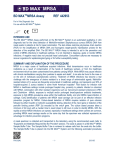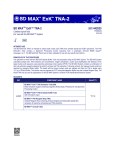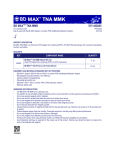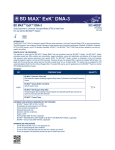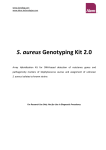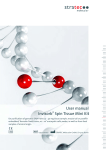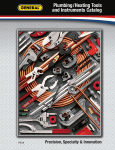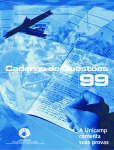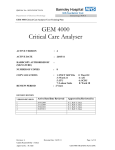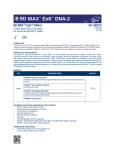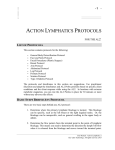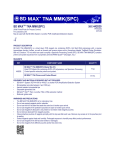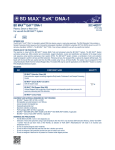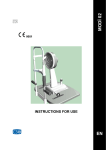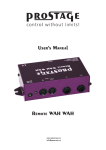Download summary and explanation of the procedure
Transcript
443461 BD MAX™ MRSA XT Assay P0167(01) 2013-09 For In Vitro Diagnostic Use For use with the BD MAX™ System INTENDED USE The BD MAX™ MRSA XT Assay performed on the BD MAX™ System is an automated qualitative in vitro diagnostic test for the rapid detection of methicillin-resistant Staphylococcus aureus (MRSA) DNA from nasal swabs in patients at risk for nasal colonization. The BD MAX™ MRSA XT Assay is intended to aid in the prevention and control of MRSA infections in healthcare settings. It is not intended to diagnose MRSA infections nor guide or monitor treatment for MRSA infections. A negative result does not preclude nasal colonization. Concomitant cultures are necessary to recover organisms for epidemiological typing or for further susceptibility testing. SUMMARY AND EXPLANATION OF THE PROCEDURE MRSA is a major cause of healthcare-acquired infections. Most transmissions occur in healthcare institutions as a result of contamination of the hands of healthcare workers, or from the healthcare environment which has been contaminated from patients carrying MRSA. While MRSA may cause infection with clinical manifestations ranging from pustules to sepsis and death1, it can also be found in the nose or on the skin of individuals (asymptomatic carriers). Treatment of MRSA infections has become a real challenge due to the broad range of antimicrobial agents. Methicillin-resistant strains of S. aureus are frequently encountered in healthcare settings, and represent over 50% of hospital-acquired S. aureus isolates in some North American hospitals. Risk factors for infection with MRSA in healthcare settings include prolonged hospital stay, proximity to patients infected or colonized with MRSA, colonization with other resistant organisms such as vancomycin-resistant Enterococci (VRE) and Clostridium difficile, exposure to multiple and/or prolonged broad-spectrum antibiotic treatments, exposure to high MRSA prevalence areas within the healthcare facility, and prior MRSA nasal infection or carriage. Early identification of patients with MRSA nasal carriage can be part of an effective infection prevention program for MRSA. Culture-based detection of MRSA requires isolation of pure colonies followed by either oxacillin or cefoxitin susceptibility testing, detection of the mecA gene or detection of the penicillin binding protein (PBP 2a) encoded by the mecA gene. The culture based process takes a minimum of 24 hours with a median time to result closer to 48 hours in order to identify MRSA. With the rapidity at which MRSA infections can spread, especially in healthcare settings where carriers are common, providing MRSA nasal carriage results on the same day that the specimen was collected represents an advantage for infection prevention programs. Active surveillance using molecular tests for rapid detection of MRSA is a proven strategy to reduce transmission in healthcare settings and prevent infection in vulnerable patients. Inaccurate detection can lead to uncontrolled transmission of MRSA and inappropriate use of healthcare resources. With other commercial assays, up to 12.9% of positive MRSA test results are incorrect because the mecA gene is absent (commonly called “dropout mutants”). These false positive results can lead to unnecessary and expensive isolation and treatment of patients1. Strains of MRSA with the newly discovered mecC gene account for 3-4% of all new MRSA cases2 but cannot be detected by assays that do not detect that gene3. These false negative results can lead to uncontrolled transmission of undetected strains of MRSA. Assay design is critical to detect MRSA accurately and ensure that appropriate infection control interventions are applied. The BD MAX™ MRSA XT assay uses eXTended detection technology to detect new strains of MRSA, including strains with the mecC gene, and decreasing false positives due to mecA/mecC dropouts. A nasal specimen is collected and transported to the laboratory using the recommended swab (refer to “Equipment and Materials Required But Not Provided” section). The swab is placed in a BD MAX™ 1 MRSA XT Sample Buffer Tube. The Sample Buffer Tube is vortexed to release cells from the swab into the buffer. The Sample Buffer Tube is placed into the BD MAX™ System and the following automated procedures occur: the bacterial cells are lysed, DNA is extracted on magnetic beads and concentrated, and then an aliquot of the eluted DNA is added to PCR reagents which contain the MRSA-specific primers used to amplify the genetic targets, if present. The assay also includes a Sample Processing Control (SPC). The SPC is present in the Extraction Tube and undergoes the extraction, concentration and amplification steps to monitor for inhibitory substances as well as process inefficiency due to instrument or reagent failure. No operator intervention is necessary once the clinical sample and reagent strip are loaded into the BD MAX™ System. The BD MAX™ System automates sample lysis, DNA extraction and concentration, reagent rehydration, nucleic acid amplification and detection of the target nucleic acid sequence using real-time polymerase chain reaction (PCR). Amplified targets are detected with hydrolysis probes labeled with quenched fluorophores. The amplification, detection and interpretation of the signals are done automatically by the BD MAX™ System. PRINCIPLES OF THE PROCEDURE The BD MAX™ System uses a combination of lytic and extraction reagents to perform cell lysis and DNA extraction. Following enzymatic cell lysis at elevated temperature, the released nucleic acids are captured by magnetic affinity beads. The beads with the bound nucleic acids are washed and the nucleic acids are eluted by heat in Elution Buffer. Eluted DNA is neutralized with Neutralization Buffer and transferred to the Master Mix Tube to rehydrate the PCR reagents. The reconstituted amplification reagent is dispensed into the BD MAX™ PCR Cartridge. Microvalves in the BD MAX™ PCR Cartridge are sealed by the system prior to initiating PCR to prevent evaporation and amplicon contamination. The amplified DNA targets are detected using hydrolysis (TaqMan®) probes labeled at one end with a fluorescent reporter dye (fluorophore) and at the other end with a quencher moiety. Probes labeled with different fluorophores are used to detect a specific amplicon in the SCCmec right-extremity junction (MREJ), the genes for methicillin resistance mecA and mecC, in three different optical channels of the BD MAX™ System: SCCmec right-extremity junction (MREJ) amplicons are detected in the 475/520 channel, methicillin resistance gene mecA and mecC amplicons are detected in the 585/630 channel, and SPC amplicons are detected in the 680/715 channel. When the probes are in their native state, the fluorescence of the fluorophore is quenched due to its proximity to the quencher. However, in the presence of target DNA, the probes hybridize to their complementary sequences and are hydrolyzed by the 5’-3’ exonuclease activity of the DNA polymerase as it synthesizes the nascent strand along the DNA template. As a result, the fluorophores are separated from the quencher molecules and fluorescence is emitted. The amount of fluorescence detected in the three optical channels used for the BD MAX™ MRSA XT Assay is directly proportional to the quantity of the corresponding probe that is hydrolyzed. The BD MAX™ System measures these signals at the end of each amplification cycle, and interprets the data to provide a result. REAGENTS REF Contents BD MAX™ MRSA XT Master Mix (C7) Dried PCR Master Mix containing polymerase, nucleotides and specific molecular probes and primers along with Sample Processing Control-specific molecular probe. BD MAX™ MRSA XT Reagent Strip Unitized Reagent strip containing all liquid reagents and disposable pipette tips 443461 necessary for specimen processing and DNA extraction. BD MAX™ MRSA XT Extraction Tube (B8) Dried extraction reagent containing DNA magnetic affinity beads, Achromopeptidase and Sample Processing Control BD MAX™ MRSA XT Sample Buffer Tube (with 25 septum caps) 2 Quantity 24 tests 24 tests 24 tests 24 tests EQUIPMENT AND MATERIALS REQUIRED BUT NOT PROVIDED BBL™ CultureSwab™ Liquid Stuart single or double swab (BD catalog no. 220099 or 220109), Copan (Venturi) Transystem®* Liquid Stuart single or double swab (Copan, catalog no. 141C or 139C) VWR Multi-Tube Vortexer (VWR catalog no. 58816-115) NALGENE®* Cryogenic Vial Holder (VWR, catalog no. 66008-783) Disposable gloves, powderless Sterile scissors (optional) Sterile Gauze Stopwatch or timer BD MAX™ PCR Cartridges (BD catalog no. 437519) WARNINGS AND PRECAUTIONS For in vitro diagnostic use. Do not use the kit if the label that seals the outer box is broken. Do not use reagents if the protective pouches are open or torn upon arrival. Close reagent protective pouches promptly with the zip seal after each use. Remove any excess air in the pouches prior to sealing. Do not remove desiccant from reagent pouches. Check reagent strips for proper liquid fills (ensure that the liquids are at the bottom of the tubes) (see Figure 1). Check reagent strips to ensure that all pipette tips are present (see Figure 1). Do not use reagents if desiccant is not present or broken inside reagent pouches. Do not use reagents if the foil has been opened or damaged. Do not mix reagents from different pouches and/or kits and/or lots. Do not use expired reagents and/or materials. Do not mix caps between tubes or re-use caps as contamination may occur and compromise test results. Proceed with caution when using chemical solutions, as Master Mix and Extraction tube barcode readability may be altered. To avoid contamination of the environment with MRSA amplicons, do not break apart the BD MAX™ PCR Cartridge after use. The seals in the BD MAX™ PCR Cartridges prevent contamination. Performing the assay outside of the recommended time ranges may produce invalid results. Assays not performed within specified time ranges should be repeated. Additional controls may be tested according to guidelines or requirements of local, state, provincial and/or federal regulations or accrediting organizations. In cases where other PCR tests are conducted in the same general area of the laboratory, care must be taken to ensure that the BD MAX™ MRSA XT Assay, any additional reagents required for testing, and the BD MAX™ System are not contaminated. Gloves must be changed before manipulating reagents and cartridges. Always handle specimens as if they are infectious and in accordance with safe laboratory procedures such as those described in CLSI Document M294 and in Biosafety in Microbiological and Biomedical Laboratories5. Wear protective clothing and disposable gloves while handling kit reagents. Wash hands thoroughly after performing the test. Do not pipette by mouth. Do not smoke, drink, or eat in areas where specimens or kit reagents are being handled. Dispose of unused reagents and waste in accordance with country, federal, provincial, state and local regulations. 3 STORAGE AND STABILITY Collected specimens should be kept between 2 °C and 25 °C during transport. Protect against freezing or exposure to excessive heat. Specimens can be stored at 2-25 °C for a maximum of 48 hours or at 2-8 °C for a maximum of 120 hours (5 days) before testing. BD MAX™ MRSA XT Assay reagents and components are stable at 2-25 °C through the stated expiration date. Do not use expired components. BD MAX™ MRSA XT Master Mix and Extraction Tubes are provided in sealed pouches. To protect product from humidity, immediately re-seal after opening. Reagent tubes are stable for up to 7 days at 2-25 °C after initial opening and re-sealing of the pouch. Unreconstituted Extraction and Master Mix reagent tubes are stable for up to 5 hours at 2-25 °C after being removed from their protective pouch. INSTRUCTIONS FOR USE Specimen Collection/Transport Using a recommended swab transport device (refer to “Equipment and Materials Required But Not Provided” section), nasal specimens should be collected according to institutional and laboratory standard operating procedures and/or the following: 1. Moisten the swab(s) with two drops (approximately 50 µL) of sterile physiological saline or use dry. 2. Carefully insert the swab(s) into the patient’s nostril (a swab tip should be inserted up to 2.5 cm (1 inch) from the edge of the nares). 3. Roll the swab(s) along the mucosa inside the nostril 5 times. 4. Insert the same swab(s) into the second nostril and repeat steps 2 and 3. 5. Place the swab(s) in its transport tube. 6. Label the transport tube. 7. Transport the swab(s) to the laboratory according to institutional and laboratory standard operating procedures (Refer to “Storage and Stability” section). Specimen Preparation NOTE: One (1) Sample Buffer Tube, one (1) Septum Cap, one (1) Master Mix (C7), one (1) Extraction Tube (B8) and one (1) Reagent Strip are required for each specimen and each External Control to be tested. NOTE: For culturing clinical specimens prior to performing the BD MAX™ MRSA XT Assay, refer to “Culturing of Clinical Specimens” section. 1. Obtain the number of Sample Buffer Tubes corresponding to the number of specimens and external controls to be run. 2. Label each Sample Buffer Tube with the appropriate patient identification making sure not to obscure, write, or label over the barcodes. 3. Remove the cap from the Sample Buffer Tube. 4. Remove the swab from the sample transport tube and place the swab in the corresponding Sample Buffer Tube. 5. Hold the swab by the stem near the rim of the tube (use sterile gauze to minimize risk of contamination). Lift the swab approximately one (1) cm from the bottom of the Sample Buffer Tube and bend the stem against the edge of the tube to break it. Alternative method: use sterile scissors to cut the stem. 6. Close the Sample Buffer Tube with a septum cap. 7. Place Sample Buffer Tube in a NALGENE®* Cryogenic Vial Holder and vortex at maximum speed for one (1) minute with the Multi-Tube Vortexer. Up to 24 samples can be processed simultaneously with the Multi-Tube Vortexer. 4 BD MAX™ System Operation NOTE: Refer to the BD MAX™ System User’s Manual for detailed instructions (“Operation” section). NOTE: The BD MAX™ MRSA XT Assay must be performed immediately after the vortexing step above (“Specimen Preparation”, Step 7). If retesting is necessary, re-vortex sample(s). 1. Turn on the BD MAX™ System and log in by entering <user name> and <password>. 2. Remove the required number of BD MAX™ MRSA XT Reagent Strips from the BD MAX™ MRSA XT Kit. Gently tap each strip onto a hard surface to ensure that all the liquids are at the bottom of the tubes. 3. Remove the required number of BD MAX™ MRSA XT Extraction Tube(s) and BD MAX™ MRSA XT Master Mix tube(s) from their protective pouches. Remove excess air, and close pouches with the zip seal. 4. For each specimen and external control to be tested, place one (1) BD MAX™ MRSA XT Reagent Strip on the BD MAX™ System Rack, starting with Position 1 of Rack A and continuing sequentially. Do not skip spaces. 5. Snap one (1) BD MAX™ MRSA XT Extraction Tube (white foil) into Position 1 of each BD MAX™ MRSA XT Reagent Strip (see Figure 1). 6. Snap one (1) BD MAX™ MRSA XT Master Mix tube (green foil) into Position 2 of each BD MAX™ MRSA XT Reagent Strip (see Figure 1). Figure 1: Snap BD MAX™ MRSA XT Extraction tubes and Master Mix tubes into reagent strip 7. On the BD MAX™ software, select the <Consumable info> tab under the Run screen. 8. Enter the kit lot number for the BD MAX™ MRSA XT Assay (for lot traceability) by either scanning the barcode with the scanner or by manual entry. NOTE: Repeat steps 7 and 8 for each new kit lot number. 9. Select the <Work List> tab, click on the <Assay> field and using the pull down menu, select <BD MAX MRSA XT >. This will automatically populate the remaining assay fields for Rack A with “BD MAX MRSA XT ”. 10. Enter the BD MAX™ MRSA XT Sample Buffer Tube ID, Patient ID and Accession Number (if applicable) for Position 1 of Rack A, either by scanning the 1D barcode with the scanner or by manual entry. 11. Click on the <Lot Number> field and using the pull down menu, select the appropriate kit lot number (on the outer box). This will automatically populate the remaining lot number fields for Rack A with the same lot number. 12. Enter the information for the next position in the Rack and continue for all remaining Sample Buffer Tubes in the rack. NOTE: Steps 11 and 12 must be repeated for each new kit lot number. 13. Repeat steps 9 to 12 for Rack B. 14. Place the BD MAX™ MRSA XT Sample Buffer Tube(s) in the BD MAX™ Rack(s) following the same order as entered in the worklist. Do not skip or leave empty positions between tubes. NOTE: Place the tubes into the sample rack with 1D barcode labels facing outward (this makes scanning tubes easier during sample login). 5 15. Place the required number of BD MAX™ PCR Cartridge(s) into the BD MAX™ System (see Figure 2). Each cartridge accommodates 2 runs of up to 12 samples for a total of 24 specimens. The BD MAX™ System will automatically select the position and row on the PCR cartridge for each run. Cartridges are used on a per-run AND rack basis (2 runs per cartridge and 1 cartridge per rack). Figure 2: Load PCR Cartridges 16. Load rack(s) into the BD MAX™ System (Figure 3). Ensure that the placement of rack(s) (left to right) corresponds to the worklist created (top to bottom). Figure 3: Load Rack(s) into the BD MAX™ System. 17. Close the BD MAX™ System lid and click the <Start Run> button to begin processing. 18. At the end of the run, check results immediately or store Sample Buffer Tubes at 2-8 °C until the results are checked. 6 NOTE: If a septum was damaged during the run, replace it with a new one before storing the specimen. NOTE: Sample Buffer Tubes can be stored at 2-25 °C for a maximum of 36 hours or at 2-8 °C for a maximum of 120 hours (5 days) after the run has been started. When an Indeterminate (IND), Unresolved (UNR), or Incomplete (INC) result is obtained, or when an External Control failure occurs, a repeat test from the Sample Buffer Tube must be performed within this timeframe (see “Repeat Test Procedure” section). QUALITY CONTROL Quality control procedures monitor the performance of the assay. Laboratories must establish the number, type and frequency of testing control materials according to guidelines or requirements of local, provincial, state and/country regulations or accreditation organizations. For general QC guidance, the user may wish to refer to CLSI MM36 and EP127. 1. An External Positive Control is intended to monitor for substantial reagent failure while an External Negative Control is used to detect reagent or environmental contamination (or carry-over) from other specimens or MRSA amplicons. External Control materials are not provided by BD. Various types of External Controls are recommended to allow the user to select the most appropriate control for their laboratory quality control program: Commercially available control materials [e.g., a reference MRSA strain (ATCC™* 43300) can be used as positive controls. Staphylococcus epidermidis strain (e.g., ATCC 12228) can be used as negative control]. Previously characterized specimens known to be positive or negative for MRSA. NOTE: It is recommended that bacterial strains be freshly prepared in saline to a turbidity of 0.5 McFarland (~1.0 x 108 CFU/mL) from isolated colonies and subsequently diluted with saline to obtain a final concentration of ~1.0 x 104 CFU/mL. Dip a swab into the diluted bacterial suspension, express the excess liquid, place the swab in a corresponding Sample Buffer Tube, and follow instructions described in step 5 of the “Specimen Preparation” section. 2. One (1) External Positive Control and one (1) External Negative Control should be run daily until adequate process validation is achieved on the BD MAX™ System. Reduced frequency of control testing should be based on a protocol and data as determined by the individual laboratory. 3. An External Negative Control that yields a positive test result is indicative of a specimen handling and/or contamination problem. Review the specimen handling technique to avoid mix-up and/or contamination. An External Positive Control that yields a negative result is indicative of a specimen handling/preparation problem. Review the specimen handling/preparation technique. 4. An External Control that yields an Unresolved, Indeterminate or Incomplete test result is indicative of a reagent or a BD MAX™ System failure. Check the BD MAX™ System monitor for any error messages. Refer to the "System Error Summary" section of the BD MAX™ System User’s Manual8 for interpretation of warning and error codes. If the problem persists, use reagents from an unopened pouch or use a new BD MAX™ MRSA XT Assay kit. NOTE: External Positive and Negative Controls are not used by the BD MAX™ System software for the purpose of sample test result interpretation. External Controls are treated as if they were patient samples. 5. Each BD MAX™ MRSA XT Assay Extraction Tube contains a Sample Processing Control (SPC) which is a plasmid containing a synthetic target DNA sequence. The SPC will be extracted, eluted and amplified along with any DNA present in the processed specimen, ensuring the predictivity of the assay. The SPC monitors the efficiency of DNA capture, washing and elution during the sample processing steps, as well as the efficiency of DNA amplification and detection during PCR analysis. If the SPC result fails to meet the acceptance criteria for a negative specimen, the result will be reported as Unresolved. An Unresolved result is indicative of specimen-associated inhibition or reagent failure. Repeat any specimen reported as Unresolved according to the "Repeat Test Procedure" section below. 7 RESULTS INTERPRETATION Results are available on the Results tab in the Results window on the BD MAX™ System monitor. The BD MAX™ System software automatically interprets test results. A test result may be called as MRSA NEG (negative), MRSA POS (positive) or MRSA UNR (unresolved) based on the amplification status of the target and of the Sample Processing Control. IND (indeterminate) or INC (incomplete) results are due to BD MAX™ System failure. Results are based on the following decision algorithm: ASSAY RESULT REPORTED MRSA POS MRSA NEG MRSA UNR IND INC INTERPRETATION OF RESULT MRSA DNA detected MRSA DNA not detected No target amplification; no SPC amplification Indeterminate due to BD MAX™ System failure (with Warning or Error Codes* ) Incomplete Run (with Warning or Error Codes* ) *Refer to the “Troubleshooting” section of the BD MAX™ System User’s Manual for interpretation of warning and error codes. MRSA POS (MRSA DNA detected) Fluorescence signal is detected for both MREJ (S. aureus specific) and mecA/mecC targets and The SPC is ignored since MRSA target amplification overrides this control. MRSA NEG (MRSA DNA not detected) Fluorescence signal is not detected by the BD MAX™ MRSA XT Assay for any target (mecA/mecC and MREJ targets) and fluorescence signal is detected for the SPC or Fluorescence signal is detected for the mecA/mecC gene only [the mecA and mecC genes are not unique to S. aureus species and can be found in other bacterial genera (e.g., S. epidermidis)]. MRSA UNR (Unresolved result) Fluorescence signal not detected for mecA/mecC, or MREJ targets; and Fluorescence signal not detected for the SPC (Inhibitory specimen or reagent failure). IND (Indeterminate result) BD MAX™ System failure with Warning or Error Codes. Refer to the “Troubleshooting” section of the BD MAX™ System User’s Manual8 for interpretation of warning and error codes. INC (Incomplete run) BD MAX™ System failure with Warning or Error Codes. Refer to the “Troubleshooting” section of the BD MAX™ System User’s Manual8 for interpretation of warning and error codes. REPEAT TEST PROCEDURE Note 1: Sufficient volume is available for one repeat test from the Sample Buffer Tube on the BD MAX™ System. For Sample Buffer Tubes stored at 2-25 °C, retesting must be performed within 36 hours of the steps covered in the “Specimen Preparation” section above. Alternatively, for Sample Buffer Tubes stored at 2-8 °C, retesting may be performed within 120 hours (5 days) of the steps covered in the “Specimen Preparation” section above. Note 2: New samples may be tested in the same run with repeat samples. Unresolved Result Unresolved results may be obtained in the event that an inhibitory substance or a reagent failure prevents proper target or SPC amplification. Sample(s) can be repeated from their corresponding Sample Buffer Tube(s) within the timeframes defined above. Vortex the sample(s) for one (1) minute and restart following the “BD MAX™ System Operation” section. 8 Indeterminate Result Indeterminate results may be obtained in the event that a System failure occurs. Sample(s) can be repeated from their corresponding Sample Buffer Tube(s) within the timeframes defined above. Vortex the sample(s) for one (1) minute and restart following the “BD MAX™ System Operation” section. For the interpretation of warning or error code messages, refer to the BD MAX™ User’s Manual8 (“Troubleshooting” section). Incomplete Result Incomplete results may be obtained in the event that a terminating warning or error code occurs or in the event that the Sample Preparation or the PCR did not reach it’s expected time points. The Incomplete results may apply to a run or a lane. Sample(s) can be repeated from their corresponding Sample Buffer Tube(s) within the timeframes defined above. Vortex the sample(s) for one (1) minute and restart following “BD MAX™ System Operation” section. For the interpretation of warning or error code messages, refer to the BD MAX™ System User’s Manual8 (“Troubleshooting” section). External Control Failure External Controls should yield expected results when tested. If specimens have to be repeated due to an incorrect External Control result, they should be repeated from their Sample Buffer Tubes along with freshly prepared External Controls within the timeframes defined above. Vortex the samples for one (1) minute and restart following the “BD MAX™ System Operation” section. CULTURING OF CLINICAL SPECIMENS In order to perform antimicrobial susceptibility testing or epidemiological typing, clinical specimens may be cultured from the collection device (swab) prior to performing the “Specimen Preparation” procedure (using a Streak-Plate method) or after the “Specimen Preparation” procedure (using an Enrichment Broth method). Immediately after the end of the initial PCR run, swabs may be stored at 2-8 °C for up to 36 hours in Sample Buffer Tubes before culturing, following hospital procedures. LIMITATIONS OF THE PROCEDURE This product is intended for use with nasal swab specimens collected using specimen collection and transport devices listed in the “Equipment and Materials Required But Not Provided” section. This product should only be used with the BD MAX™ System. Incorrect test results may occur from improper specimen collection, handling or storage, technical error, sample mix-up or because the number of organisms in the specimen is below the analytical sensitivity of the test. Careful compliance with the package insert instructions and the BD MAX™ System User’s Manual8 are necessary to avoid erroneous results. Good laboratory technique is essential for the proper performance of this assay. Due to the high analytical sensitivity of this test, extreme care should be taken to preserve the purity of all materials and reagents. Screening determines the colonization status at a given time. Colonization may vary depending upon patient treatment (e.g., decolonization regime), patient status (e.g., transient MRSA colonization) or exposure to high-risk environments (e.g., contact with MRSA carrier and/or prolonged hospitalization). Colonization status should be monitored according to institutional policies. A BD MAX™ MRSA XT positive result does not necessarily indicate eradication treatment failure since DNA presence may persist. A negative result following a previously positive test result may indicate eradication treatment success or may occur due to intermittent colonization. A positive test result does not necessarily indicate the presence of viable organisms. A positive result is indicative of the presence of MRSA DNA. The BD MAX™ MRSA XT Assay simultaneously detects the mecA/mecC gene carried within the SCCmec cassette and a S. aureus specific sequence located within the junction of the SCCmec cassette and the orfX gene (MREJ). The BD MAX™ MRSA XT Assay is designed to detect MREJ genotypes i, ii, iii, iv, v, vi, vii, ix, xiii, xiv and xxi which represents most of mecA and mecC harboring MRSA strains (belonging to different SCCmec/MREJ types) accounting for more than 98% of worldwide strains tested by BD to date. Polymorphisms or mutations in regions detected by this assay may impair detection of new or unknown MRSA variants resulting in a false negative result. The BD MAX™ MRSA XT Assay performance in detecting modified S. aureus (MOD-SA) is not known as those strains have not been evaluated. The mechanism of oxacillin resistance in MOD-SA strains is 9 due to changes in affinity of penicillin binding proteins for oxacillin. MOD-SA strains are rare in the United States. As with all PCR-based in vitro diagnostic tests, extremely low levels of target below the LoD of the assay may be detected, but results may not be reproducible. Tobramycin may interfere with the BD MAX™ MRSA XT Assay (refer to “Interfering Substances” section for further details). False negative results may occur due to loss of nucleic acid from inadequate collection, transport or storage of specimens, or due to inadequate bacterial cell lysis. The Sample Processing Control has been added to the test to aid in the identification of specimens that contain inhibitors to PCR amplification and as a control for reagent integrity and of the assay system as a whole. The Sample Processing Control does not indicate if nucleic acid has been lost due to inadequate collection, transport or storage of specimens, or if bacterial cells have been adequately lysed. In a mixed culture, the detection of MRSA is variable when extremely high concentrations of MRSE are present. Competition from MRSE was observed at an MRSA:MRSE ratio of 1:1x103. BD MAX™ MRSA XT Assay results may sometimes be Unresolved due to an invalid Sample Processing Control, or be Indeterminate or Incomplete due to instrument failure, and require retesting that can lead to a delay obtaining final results. Mutations or polymorphisms in primer- or probe-binding regions may affect detection of new or unknown MRSA, resulting in a false negative result with the BD MAX™ MRSA XT Assay. As with all in vitro diagnostic tests, positive and negative predictive values are highly dependent on prevalence. BD MAX™ MRSA XT Assay performance may vary depending on the prevalence and population tested. The BD MAX™ MRSA XT Assay requires use of three (3) optical channels from the BD MAX™ System; 475/520 channel, 585/630 channel and 680/715 channel. Performance of the remaining optical channel has not been established with this assay. EXPECTED VALUES In the BD MAX™ MRSA XT Assay clinical study a total of 2393 reportable results, from specimens compliant at the specimen and PCR levels, were obtained from 3 geographically diverse sites and compared with Direct and Enriched culture. The study population was grouped into in-patient, out-patient categories. The number and percentage of positive cases, as determined by the BD MAX™ MRSA XT Assay, are presented in the table below: BD MAX™ MRSA XT Assay Group Total Number of Specimens1 Number of MRSA Positive Positive MRSA Percentage In-patient 1683 178 10.6% (178/1683) Out-patient 710 28 3.9% (28/710) Total1 2393 206 8.6% (206/2393) 1Total specimens based on compliant PCR results. PERFORMANCE CHARACTERISTICS Clinical Performance Clinical performance characteristics of the BD MAX™ MRSA XT Assay were determined in a multi-site prospective investigational study. Three (3) investigational centers participated in the study. To be enrolled in the study, patients had to be eligible for MRSA testing according to institutional policies. Eligibility requirements for targeted screening as per clinical site policies included, but were not limited to: patients admitted into the particular healthcare system; patients admitted to the Intensive Care Unit; patients transferred to the Intensive Care Unit; pre-elective surgery patients; and patients being admitted from longterm care facilities. Specimens from patients previously enrolled in the study were excluded. 10 The Comparative Reference Method consisted of direct culture complemented by enriched culture. Enriched culture analysis was completed for all specimens that were negative for MRSA by direct culture. Presumptive S. aureus colonies observed on selective (S. aureus) chromogenic medium were subcultured onto Blood Agar (BA). Identification was confirmed with an agglutination test, while methicillin resistance was confirmed by Cefoxitin disk (30 μg) diffusion susceptibility testing. Enrichment in Trypticase Soy Broth with 6.5% NaCl (TSB 6.5% NaCl) was completed in the event that MRSA was not confirmed by the initial direct culture method. Turbid TSB 6.5% NaCl broth was used to inoculate additional chromogenic medium and BA plates; MRSA confirmation was performed as described above. A total of 2451 specimens were enrolled in the study. Of those, 94 specimens were regarded as noncompliant per protocol criteria and five (5) fully compliant specimens gave final non-reportable PCR results. A total of 2352 specimen results were used to determine the clinical performance of the BD MAX™ MRSA XT Assay (Table 1). Compared to the Reference Method (Direct/Enriched Culture), the BD MAX™ MRSA XT Assay identified 93.1% of the MRSA positive specimens and 97.5% of the MRSA negative specimens (Table 1). For the population tested, this resulted in a Negative Predictive Value (NPV) of 99.5% and a Positive Predictive Value (PPV) of 73.2%. Table 1: Results Obtained for MRSA with the BD MAX™ MRSA XT to the Reference Method Reference Method All Sites MRSA Positive Negative Positive 149 541 BD MAX™ MRSA XT 1 Negative 11 2138 Assay Total 160 2192 Sensitivity: 93.1% (149/160) (95% CI: 88.1%, 96.1%) Specificity: 97.5% (2138/2192) (95% CI: 96.8%, 98.1%) PPV: 73.2% (95% CI: 67.8%, 78.3%) NPV: 99.5% (95% CI: 99.1%, 99.7%) Assay in Comparison Total 203 2149 2352 1Further investigation was performed on specimens with discordant results between the Reference Method and the BD MAX™ MRSA XT Assay. 12 of 54 MRSA False Positive BD MAX™ MRSA XT specimens were also found to be positive after repeat of Reference Method 5 of 11 MRSA False Negative BD MAX™ MRSA XT specimens were also found to be negative after repeat of Reference Method. Based on this analysis, the BD MAX™ MRSA XT Assay Positive and Negative Percent Agreement with the Reference Method for MRSA are 96.4% and 98.1%, respectively. A total of 2451 specimens were enrolled in the study. Of those, 2397 nasal swab specimens were found compliant at the specimen, Direct culture and PCR level and 6 nasal swab specimens gave non reportable results. A total of 2391 specimen results were used to determine the positive and negative percent agreement of the BD MAX™ MRSA XT Assay (Table 2). Compared to Direct culture, the BD MAX™ MRSA XT Assay identified 96.5% of the MRSA positive specimens and 96.9% of the MRSA negative specimens (Table 2). Table 2: Results Obtained for MRSA with the BD MAX™ MRSA XT Assay in Comparison to Direct Culture Direct Culture All Sites Positive Negative Total Positive 137 69 206 BD MAX™ MRSA XT Assay Negative 5 2180 2185 Total 142 2249 2391 Positive Percent Agreement: 96.5% (137/142) (95% CI: 92.0%, 98.5%) Negative Percent Agreement: 96.9% (2180/2249) (95% CI: 96.1%, 97.6%) 11 Out of 2399 nasal swab specimens compliant at the specimen and PCR level, tested with the BD MAX™ MRSA XT Assay, 16 (0.7%) were reported as Unresolved after initial testing. The Unresolved Rate after repeat testing was 0.1% (2/2398) (Table 3). Table 3 Unresolved Rates Initial Unresolved Rates Unresolved Rates After Repeat 0.7% (16/2399)* (95% CI: 0.4%, 1.1%) 0.1% (2/2398) (95% CI: 0%, 0.3%) *Total number based on compliant specimens and BD MAX™ MRSA XT Assay results Out of 2399 nasal specimens tested with the BD MAX™ MRSA XT Assay, 14 (0.6%) were initially reported as Indeterminate. No result remained Indeterminate upon repeat (two specimens were not retested). Out of 2399 nasal specimens tested with the BD MAX™ MRSA XT Assay, 8 (0.3%) were initially reported as Incomplete. No result remained Incomplete upon repeat (one specimen was not retested). Analytical Sensitivity The analytical sensitivity (Limit of Detection or LoD) for the BD MAX™ MRSA XT Assay was determined as follows: positive specimens were prepared by soaking swabs in a wide range of MRSA bacterial suspensions prepared and quantified from cultures. The tested strains included 11 MRSA strains representing 11 MREJ genotypes (i, ii, iii, iv, v, vi, vii, ix, xiii, xiv and xxi) corresponding to 5 SCCmec types (I, II, III, IV and XI). The swabs were then eluted in simulated nasal matrix. Each MRSA strain was tested in replicates of 24 per concentration by 2 different operators using 3 different production lots of the BD MAX™ MRSA XT Assay. Analytical sensitivity (LoD), defined as the lowest concentration at which 95% of all replicates tested positive, ranged from 64 to 343 CFU/swab (Table 4) for the detection of MRSA strains. Table 4: Limit of Detection of MRSA Genotypes by the BD MAX™ MRSA XT Assay LoD Concentration MRSA Strain MREJ Genotype SCCmec type1 [CFU/swab (95% Cl2)] 1 Type i I 84 (49, 142) 2 Type ii II 103 (64, 167) 3 Type iii III 160 (93, 278) 4 Type iv III 68 (42, 109) 5 Type v IV 128 (73, 225) ND3 6 Type vi 343 (186, 632) 7 Type vii II 219 (110, 439) 3 ND 8 Type ix 144 (82, 255) ND3 9 Type xiii 64 (36, 114) 3 ND 10 Type xiv 78 (48, 127) 11 Type xxi4 XI 112 (64, 197) SCCmec type does not correlate to the MREJ type as these are two different typing methods. Cl: Confidence Intervals 3ND = not determined 4mecC-containing MRSA strains (Also known as mecALGA251 strain) 1 2 Analytical Inclusivity An analytical inclusivity study was performed using a variety of MRSA strains, taking into account geographic origin, MREJ genotype (wild type and mutant), SCCmec type, Pulsed-Field Gel Electrophoresis (PFGE) type, temporal diversity and susceptibility pattern. Seventy-seven (77) MRSA strains from 27 countries were tested in this study, including strains from public collections and from well-characterized clinical isolates, including Vancomycin-Resistant Staphylococcus aureus (VRSA) and Vancomycin Intermediate Staphylococcus aureus (VISA) strains. The BD MAX™ MRSA XT Assay detected MREJ types i, ii, iii, iv, v, vi, vii, ix, xiii, xiv and xxi when tested at low bacterial load (2-3 x LoD). The BD MAX™ MRSA XT Assay detected MRSA SCCmec types I, II, III, IV, V, VI, VII, VIII and XI as well as MRSA PFGE types USA 100 to 800, 1000 and 1100 at 2-3 x LoD. All MRSA strains displaying additional resistance to vancomycin (VRSA and VISA) were also detected. 12 Evaluation of a Well Characterized Challenge Strain Panel An additional analytical study was carried out to evaluate the analytical performance of the BD MAX™ MRSA XT Assay using a well characterized challenge strain panel: Seventeen (17) out of 17 MRSA strains with high and low oxacillin minimum inhibitory concentrations (MICs), including PFGE types USA 100 to 800, 1000, PFGE type IV/IBERIAN and mecC variant (mecA-containing S. aureus strain LGA251) tested at a concentration of 2-3 x LoD, exhibited MRSA POS results. Four (4) out of 4 BORSA strains (Borderline oxacillin-resistant S. aureus) tested at ≥106 CFU/swab, exhibited MRSA NEG results. Five (5) out of 5 MSSA strains tested at ≥106 CFU/swab, exhibited MRSA NEG results One (1) out of 1 methicillin-resistant Staphylococcus epidermidis (MRSE) strains tested at ≥106 CFU/swab, exhibited a MRSA NEG result. Analytical Specificity The BD MAX™ XT Assay was performed on samples containing high levels of non-target organisms, using the BD MAX™ System, to demonstrate the specificity of the assay for detection of MRSA. Fifty-seven (57) out of 57 strains of various non-staphylococcal species tested at a concentration of at least ≥106 CFU/mL (except for Cryptococcus neoformans which was tested at 3x105 CFU/swab) produced MRSA NEG results. Forty-five (45) coagulase-negative staphylococcal strains (CoNS) and coagulase-positive staphylococcal strains (CoPS) representing 28 species were tested at a concentration of 0.5 McFarland with the BD MAX™ XT Assay. Forty-five (45) of the 45 strains tested exhibited MRSA NEG results. Sixty-five (65) MSSA strains (including 15 empty cassette variant MSSA strains) tested at high concentrations (≥106 CFU/swab), produced MRSA NEG results. Seventeen (17) viruses representing 12 different viral species were tested at ≥ 105 PFU/mL. All 17 viruses produced MRSA NEG results. Interfering Substances Twenty nine (29) microorganisms and chemical substances which might be used in the nares or found in nasal swab specimens were evaluated for potential interference with the BD MAX™ MRSA XT Assay (Table 5). MRSA negative and MRSA positive samples at 2-3 x LoD were tested with the highest amount of each compound likely to be found at the sampling site or on the nasal swab sample. Results demonstrated no reportable interference with any microorganisms or chemical substance except for Tobramycin which showed inhibition in the BD MAX™ MRSA XT Assay when tested at a concentration of 4.5 x 10-3 g/swab. Table 5: Endogenous and Exogenous Substances Tested with the BD MAX™ MRSA XT Assay Substance Result1 Substance Mucin, from bovine submaxillary glands Dexamethasone Sodium Phosphate Ophtalmic Solution USP, 0.1% Dexamethasone Phosphate Equivalent Chloraseptic®* Taro-Mupirocin, Mupirocin Ointment USP, 2% Long Lasting Dristan®* Nasal Mist Neo-Synephrine®* ® Equate * Nasal Spray Decongestant Beconase AQ®* Flunisolide Nasal Solution USP, 0.025% Nasacort®* AQ Nasonex®* NI NI NI NI NI NI NI NI NI NI NI Relenza®* NI Tobramycin Blood Flumist®* I NI NI 1NI: No reportable interference with the BD MAX™ MRSA XT Assay. I: Reportable interference with the BD MAX™ MRSA XT Assay. 13 aqua®* Rhinocort Zicam®* No-Drip Liquid Nasal Gel™* Extreme Congestion Relief Fluticasone Propionate Luffeel®* Staphylococcus epidermidis Micrococcus luteus Enterococcus faecium Enterococcus faecalis Escherichia coli Corynebacterium flavescens Moraxella catarrhalis Staphylococcus hominis subsp hominis Haemophilus influenzae Streptococcus pneumoniae Result NI NI NI NI NI NI NI NI NI NI NI NI NI NI Precision Within-laboratory precision was evaluated for the BD MAX™ MRSA XT Assay at one (1) site. The Precision panel consisted of 4 sample categories near the LoD. Each specimen contained simulated nasal matrix. MRSA strains were tested as follows: Moderate Positive (MP): ≥ 2 and ≤ 5 x LoD Low Positive (LP): ≥ 1 and < 2 x LoD High Negative (HN): < 1 x LoD True negative (TN): Negative samples (no target) Testing was performed in duplicate, over 12 days, with 2 runs per day, by 2 different technologists. Precision study results for TN, MP, LP, and HN MRSA samples demonstrated 100%, 100%, 97.9%, and 60.4% agreement, respectively. Reproducibility The reproducibility study was performed using the same sample categories as defined above for the Precision Study. Samples in each category were tested in triplicate, on 5 distinct days, wherein each day 2 panels were tested by 2 different technologists, at 3 clinical sites using 1 lot of reagents (Site-to-Site). One (1) of these clinical sites participated in an extended study where 2 additional lots of reagents were tested (Lot-to-Lot). Results are shown for each sample category with the data from MRSA strains. For Site-to-Site Reproducibility, the overall percent agreement was 100% for MRSA MP and TN categories; 96.7% for MRSA LP; and 63.3% for MRSA HN (Table 6). Table 6: Site-To-Site Reproducibility Study Results Using One Lot of the BD MAX™ MRSA XT Assay Overall Percent Agreement SITE Category 1 2 Site 1 Percent Count Agreement Site 2 Percent Count Agreement Site 3 Percent Count Agreement Percent CI2 95% HN1 MRSA 60.0% 18/30 66.7% 20/30 63.3% 19/30 63.3% (53.0%, 72.6%)2 LP MRSA 95.0% 57/60 98.3% 59/60 96.7% 58/60 96.7% (92.9%, 98.5%) MP MRSA 100.0% 30/30 100.0% 30/30 100.0% 30/30 100.0% (95.9%, 100.0%) TN 100.0% 30/30 100.0% 30/30 100.0% 30/30 100.0% (95.9%, 100.0%) Percent Agreement correlates to the percent of negative results. Confidence Interval For Lot-to-Lot Reproducibility, the overall percent agreement was 100% for MRSA MP and TN; 96.7% for MRSA LP; and 61.1% for MRSA HN (Table 7). Table 7: Lot-To-Lot Reproducibility Study Results using Three Lots of the BD MAX™ MRSA XT Assay Overall Percent Agreement LOT Category 1 2 Lot 1 Percent Count Agreement Lot 2 Percent Count Agreement Lot 3 Percent Count Agreement Percent CI2 95% HN1 MRSA 63.3% 19/30 63.3% 19/30 56.7% 17/30 61.1% (50.8%, 70.5%2) LP MRSA 96.7% 58/60 96.7% 58/60 96.7% 58/60 96.7% (92.9%, 98.5%) MP MRSA 100.0% 30/30 100.0% 30/30 100.0% 30/30 100.0% (95.9%, 100.0%) TN 100.0% 30/30 100.0% 30/30 100.0% 30/30 100.0% (95.9%, 100.0%) Percent Agreement correlates to the percent of negative results. Confidence Interval 14 Carry-Over / Cross-Contamination A study was conducted to investigate the potential for cross-contamination between high MRSA (≥107 CFU/swab) specimens and negative specimens throughout the BD MAX™ MRSA XT workflow. Overall, from 210 reportable results, 3 false positive results were obtained (1.4%) due to carry-over contamination. REFERENCES 1. 2. 3. 4. 5. 6. 7. 8. Blanc et al., High Proportion of Wrongly Identified Methicillin-Resistant Staphylococcus aureus Carriers by Use of a Rapid Commercial PCR Assay Due to Presence of Staphylococcal Cassette Chromosome Element Lacking the mecA Gene. J. Clin. Microbiol 2011;49:722724. Petersen et al., Epidemiology of methicillin-resistant Staphylococcus aureus carrying the novel mecC gene in Denmark corroborates a zoonotic reservoir with transmission to humans. Clin Microbiol Infect. 2013;19:E16-E22 Shore et al., Detection of Staphylococcal Cassette Chromosome mec Type XI Carrying Highly Divergent mecA, mecI, mecR1, blaZ, and ccr Genes in Human Clinical Isolates of Clonal Complex 130 Methicillin-Resistant Staphylococcus aureus, Antimicrob. Agents and Chemother. 2011;55:3765-3773 Clinical and Laboratory Standards Institute. Protection of laboratory workers from occupationally acquired infections; Approved Guideline. Document M29 (Refer to the latest edition). Centers for Disease Control and Prevention, and National Institutes of Health. Biosafety in microbiological and biomedical laboratories. Chosewood L.C. and Wislon D.E. (eds) (2009). HHS Publication No. (CDC) 21-1112. Clinical and Laboratory Standards Institute. Molecular Diagnostic Methods for Infectious Diseases; Approved Guideline, Document MM3 (Refer to the latest edition). Clinical and Laboratory Standards Institute. User Protocol for Evaluation of Qualitative Test Performance; Approved Guideline, Document EP12 (Refer to the latest edition) BD MAX™ System User’s Manual (refer to the latest version) BD Diagnostics, Sparks, MD, USA 15 This product is sold under license, and purchase of this product does not include rights to use for certain blood and tissue screening applications, nor for certain industrial applications. The purchase of this product allows the purchaser to use it for amplification and detection of nucleic acid sequences for providing human in vitro diagnostics. No general patent or other license of any kind other than this specific right of use from purchase is granted hereby. BD Diagnostics Technical Service: 1.800.638.8663 GeneOhm Sciences Canada, Inc. 2555 Boul. du Parc Technologique Québec (QC), G1P 4S5, Canada Benex Limited Rineanna House Shannon Free Zone Shannon, County Clare, Ireland Made in Canada. *Brands are trademarks of their respective owners. BD, BD Logo and all other trademarks are property of Becton, Dickinson and Company. © 2013 BD. 16
















